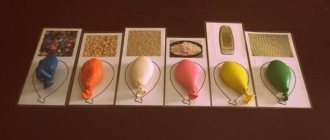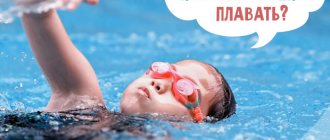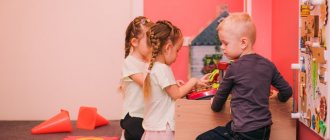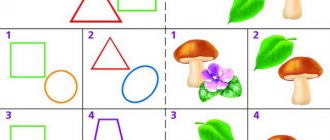The best puzzles for young children are so durable and wooden. Older preschoolers may be ready for 24-piece puzzles.
Age appropriate activities.
Children will only develop their concentration when they engage in age-appropriate activities. If you give your child a puzzle that is too difficult, he will give up early and lose motivation.
If the task is too difficult or too long, your child will not find it meaningful and will lose interest. Doing complicated or formal events will have the opposite effect of what you may have intended .
An appropriate amount of time to expect a child to focus on just one activity is approximately 2-3 minutes per year.
If you offer short activities that are challenging but not overwhelming, your child will gradually begin to spend a little more time as they get older.
Screen time
Did you know that screen time reduces your child's attention span?
I once had a parent meeting where I had to tell a mom that her 4 year old was having a hard time paying attention in class. He could barely concentrate for a minute or two and couldn't follow what the class was doing. His mother was shocked and told me that he could for hours watching TV.
There was a problem.
Watching TV is not concentrating. Children are not actively engaged. They look at the device passively.
When a child watches TV, the images on the screen flash at a speed that is unnatural for the brain. With repeated exposure, the brain gets used to this stimulus.
When the child then tries to interact with his normal environment, he struggles to process the information that flashes at a natural rate.
A bit scary.
Screen time is unavoidable these days, but it can definitely be managed wisely.
Daily routine
Maintaining a daily routine will help your child become accustomed to daily activities and teach them patterns.
When children know what's coming next, they are more likely to participate and do it. If your child knows that now is the time for indoor play, he will quickly settle in and find a suitable play activity.
You won't struggle every day to get them off the TV because their 20 minutes of TV will have their own time slot. Routine also provides a sense of security.
This gives you the opportunity to schedule activities into your day that encourage concentration.
Sleep and nutrition
Eating a healthy diet and getting enough hours of sleep per night will have a huge impact on your child's ability to concentrate.
Make sure bedtime is an integral part of this routine, as is a healthy breakfast. What your child eats in the morning has a direct impact on their ability to focus during the school day.
Reading to your child
Unlike watching TV, when you read to your child, it requires real attention and listening.
Reading to your child is one of the most beneficial things you can do. This is a fun and easy way to improve your child's concentration every day.
The more interested your child is in the story, the more he will hang on to every word and pay attention.
Read about why bedtime stories are so important.
For me, there's nothing better—or more educational—than a good Dr. Seuss or Julia Donaldson story. My kids can never get enough of them.
They are so good for learning vocabulary and developing auditory awareness (through rhyming and repetition) and they are so interesting that your kids will pay attention.
Regular exercise.
It has been proven that exercises develop a child’s concentration. It helps with memory, attention, mental acuity and reduces anxiety as well as increasing a child's energy.
Make sure your children are active. The best way to do this is to encourage regular free play, especially outdoors.
How does your child learn?
Children have different learning styles and will concentrate and learn better in their preferred style.
Visual learners prefer to see what they are learning, auditory learners prefer to hear what they are learning, and kinesthetic learners need to touch and experience to learn. Most young children prefer kinesthetic learning and learn best through physical experiences.
Pay attention to how your child pays attention best!
Traffic breaks
Exercise not only helps develop children's overall attention span, but also helps them instantly regain their strength and recharge their energy.
The most effective way to take a break during class is movement .
Think about how you feel when you sit at a computer for several hours and work. Simply get up, make some coffee and walk for 2 minutes to reset your body and leave you feeling refreshed when you get back to work.
Stop your preschooler frequently during long tasks and take breaks for movement. They can last only a minute. They will improve blood circulation and increase your child's concentration so that he can continue studying for a few more minutes.
For children, movement breaks not only help them refresh and reset, but also provide an opportunity to develop gross motor skills such as fundamental strength, coordination and balance, and even cognitive skills.
Here are 18 quick break exercises to try and improve your young child's attention span. They are also great for older children.
Does my child have ADHD?
ADHD, or attention deficit hyperactivity disorder, is characterized by impulsivity, hyperactivity, or lack of attention. Some children exhibit all three qualities.
If you feel that your child is struggling to concentrate, it could be due to several factors such as anxiety, immaturity, anger, etc. You cannot just assume that it is ADHD.
The best thing to do is to monitor your child and be aware of their ability to focus. If your 5-year-old can't concentrate on anything or is jumping from one task to another every minute, seek professional advice.
ADHD can only be diagnosed by a professional so that you can take the right steps and support. Very often there may be other underlying causes that can also be addressed with advice.
Games and exercises to develop attention
Exercise “Tangled Lines”
Age: from 3 years
The essence of the exercise is to follow the tangled line from start to finish. You can draw such lines yourself, or you can use ready-made labyrinths. This exercise perfectly develops concentration and perseverance.
Game "Search"
Age: from 3 years
You show your child pictures of objects, among which you need to find a special one that is different from the rest. It may be a different size, shape or color. Gradually complicate the task: ask to find the desired pattern, which stands out only with a small detail. Step by step increase the number of unique items.
Children of all ages love these games. Practice finding differences in our exercise.
In addition to entertainment, object search tasks develop voluntary attention, increase its concentration and increase its volume.
Game "Find the odd one out"
Age: from 4 years
The task is simple - you read a short text to the child, and he claps if he hears inappropriate, “extra” words. For example, three birds were sitting on a branch: a bullfinch, a tit and a monkey. The boy Vitya flew nearby. He heard the birds quack and stopped, their singing sounded so beautiful!
You can come up with your own funny stories or simply replace the words in your child’s favorite fairy tales. The game “Find the odd one out” increases children’s concentration and intelligence, and also improves auditory memory.
Game "Where are the mistakes?"
Age: from 5 years
Prepare in advance a picture in which mistakes were made. For example, in a picture of a winter landscape, draw a beach umbrella, a fan and a hat. The number of errors depends on age: for five-year-olds, 5-6 are enough. For older children there should be more mistakes.
Systematic searches for errors make attention more stable, increasing its concentration.
Game "Numbers"
Age: from 5 years
The adult shows the child a series of numbers that must be remembered in the same order. For example, 1, 2, 3, 5, then 2, 4, 6, 8, 1 and so on. The older the baby, the longer the row can be, but usually it does not exceed 7-8 digits.
The game expands the attention span and develops auditory memory, and also teaches you to analyze and group objects (numbers).
Game "Let's start charging!"
Age: 4-6 years
Let's do some exercises? But not the usual one, but a special “attentive” one! The presenter names the parts of the body and shows them on himself, and the children repeat them. Then the adult begins to confuse the kids, calling one thing and showing another. The child who makes the least mistakes wins.
This fun game develops voluntary attention, auditory memory and motor coordination.
Rules for training voluntary attention
Voluntary attention is a special type; its implementation requires goal setting and volitional efforts. In preschool children, neither one nor the other has yet been developed. Parents should develop all this by teaching their preschoolers to be independent. To properly work on developing voluntary attention at home, it is necessary to follow certain rules:
- Consistency and systematicity of classes.
- Working on voluntariness is difficult for young children. To make complex activities attractive to children, you need to start with easy-to-perform exercises, gradually moving on to more complex ones.
- Training to develop voluntary attention is carried out in two positions:
- Special exercises for the basic properties of attention.
- Special tasks for developing attentiveness and eliminating attention depletion.
TECHNIQUES FOR INCREASING ATTENTION
We have seen that developing the ability to concentrate is of particular importance for preschoolers. And parents should train their children using an unobtrusive game form. Let's highlight a few tricks and techniques that you can use.
- Maintaining interest. Using game forms, you can ensure that the child will study with great pleasure and, accordingly, attentively.
- Stick to the duration of your classes. So, when studying numbers with a 4-year-old child, you need to understand that the child is able to hold attention for no more than 20 minutes, so it is better to keep the educational material within this framework.
- Favorite characters and toys will also help you not lose interest, and therefore listen and perceive what the parent is saying.
- Show by example. You can explain to the child that if he is attentive and tries to fulfill his parents’ instructions, then the result (for example, a tower of blocks) will turn out much better than if he worked without concentration, somehow.
- Reading and attention are interconnected, so to improve the second, you can teach your child the first. While the baby is just getting acquainted with letters, the mother can read interesting fairy tales and stories to him. Afterwards, you definitely need to discuss what you read, asking to retell it, asking questions. This will help you find out how carefully the baby listened.
If the baby has trouble concentrating and is very far from his age norm, then he may have shallow breathing. Inflating balloons, soap bubbles, playing the pipe or whistle will help correct the situation. In addition, studies have proven that walks in the fresh air and active sports games are very beneficial for children.
Solution
Many parents, faced with the problem of “hyperactivity,” resort to drug therapy (as prescribed by a doctor, of course).
They create topics and blogs and share their own experiences. No one will be surprised by topics like: “What to drink?”, “Who to contact?”; “What medications did you take?” Parents decide whether to treat a child with drugs or not after consulting a doctor. The true way out of the situation is corrective classes to develop concentration, memory, sensory and visual perception.
If a child does not have concentration, parents wonder: “What to do?” Set a routine for your child. Rising, bedtime, daytime and nighttime sleep should always begin at the same time. The baby's life should be confined to a strict schedule. This is necessary so that the baby gradually learns to predict his actions. For example, after a night's sleep, he will go to the bathroom himself to perform water procedures.
The first thing you need to learn is to observe the required rituals. After walking outside, be sure to wash your hands, and before going to bed, read a book or tell a story. This way the baby will be able to switch and tune in to the usual type of activity that follows the ritual.
Second, get used to single-tasking, which I mentioned above. Example - if you eat, do it in a certain place without outside entertainment (cartoons, music, etc.).
Third, walks in the forest, in the park, in a quiet place to clear RAM.
conclusions
In order for a child to absorb information well and be able to study successfully at school, it is necessary to devote enough time to developing his attention. When choosing games and exercises for your child, focus on his age, interests and individual characteristics. If the child does not want to complete a task or is very tired, you need to try to understand what is causing this: uninteresting material, difficulty of the task, bad mood or well-being. With the right approach, all cognitive processes of preschoolers, including attention, develop very quickly.
Perform developmental exercises from Ikyusha
Mathematics
Reading
The world
Logics
English language
Anagrams
Age: from 5-6 years
Anagrams are the rearrangement of letters in a word to form a new word. For example, sleep is nose, rakask is paint. Anagrams work well for children who can already read.
Such tasks increase concentration and speed of thinking, and also develop visual memory.
Schulte tables
Age: from 5 years
Many parents have heard about Schulte tables. These exercises are very popular as they increase concentration and develop memory in a light playful way. The child’s task is simple - to find in order the numbers or letters randomly located in the table. The sizes of the table vary depending on the age and preparation of the baby (usually from 3x3 to 16x16).
Exercise “Listen and count”
Age: 6-8 years
Another great exercise for focusing attention. You read the sentence while tapping your pencil or pen on the table. The child needs to remember both the text and the number of your strokes. If the baby begins to cope easily, complicate the task by gradually increasing the number of blows.
Games and exercises for memory development
Memory Game
Age: from 3 years
This is one of the most famous and favorite memory development games for children. Otherwise it is called “Find a Pair”. The game is a set of paired pictures with the same designs: for the little ones it is usually 12 cards (6 pairs), for older children the number increases. The idea is simple - find identical pairs from the total number of cards lying face down. If the cards match, the player takes them, if not, returns them back.
There are a lot of both paper memories and online games. Ikyusha also loves such exercises, try to find the pairs faster than him?
Game "What's gone?"
Age: from 3 years
An excellent game for developing visual memory and increasing attention span, which does not require additional materials.
Place 4-5 toys or small objects in front of your child for a minute and ask him to turn away. Then remove one item and ask what is missing? The kid must name what is missing. If the game is boring, diversify it by adding a new item.
The task must be gradually made more difficult, increasing both the total number of toys and those that we add or remove. Focus on the child’s age: for example, by the age of 6-7 years, a child can easily remember up to 10 objects.
Choose a pattern
Exercise “Fold the pattern”
Age: from 4 years
Make a pattern or lay out a drawing from simple geometric shapes (can be cut out of cardboard) or construction set parts and ask your child to remember it. Then the child needs to turn away for a while, and during this time you change the location of one figure or part. The baby’s task is to find changes and restore the pattern.
At first you can start with 3-4 parts, gradually increasing their number. If the child can do it easily, remove several parts or all at once, asking him to reassemble the pattern.
This exercise develops memory and imagination, increases the volume and concentration of attention.
Choose a pattern
Game “Remarkables”
Age: from 5 years.
Ask your child to close his eyes and list everything he saw in the room, indoors, outside. The more small details he remembers, the better! Ask your child leading questions if it is still difficult for him to answer. For example, how many children play in the sandbox? Did the cashier at the store have long or short hair? How many cups were there on the table?
Game "Locomotive"
Age: 4-7 years
This is a very fun and entertaining game for a small group of children. The idea is simple - the first child names any object, the next player repeats the word and names his own. The third child repeats what the first two said and adds himself, and so on.
“Locomotive” helps to increase memory capacity, develop auditory perception and voluntary attention. You can also consolidate the material in this way, for example, by naming only fruits, vegetables, trees, flowers.








